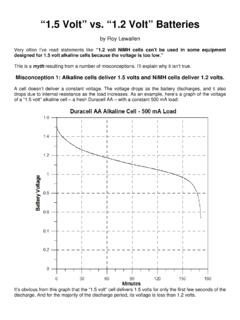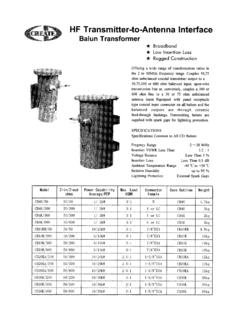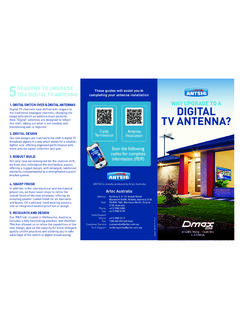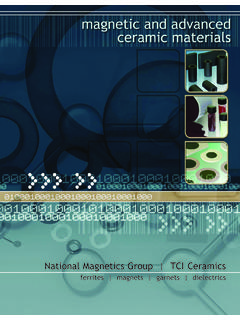Transcription of Balun : What They Do and How they Do It - EZNEC
1 Bal uns: What They DoAnd How They Do ltBy Roy lV. Lewallen,* IVTEL*5470 SW 152nd Ave., Beaverton, OR 97007I've always been a bit bothered by balunstsince I was never sure what they are supposed to dotlet alone hotv they might go about doing it. Themajority of articles deal with various ways ofbuilding and testing baluns, or the advantages ofone type over another, but almost never a word aboutwhen or why a Balun is neeessaryr if at all. Likemost amateurs, there have been few occasions when Ihave been able to tell if a Balun has any effect onan antenna system, and when it has, the effecthasn't always been good! The turning point came whenI was trying to measure the resonant frequency of afolded dipole through a one-vravelength coaxial bridge null varied a great deal as I moved myhand around the coaxial cable, or if the line orbridge was moved.
2 A hastily eonstructed Balun in-stalled at the center of the dipole eliminated theproblem. But why?I found a brief, but clear explanation of onephenomenon involved in a paper by lllaxwell' , many questions remained. This led me to aninvestigation of just how baluns are supposed towork, and what problems they are supposed to surprising conclusion I found from my researchis that one popular type of Balun ' when properlydesigned and used in an antenna system, may notsolve the probiems that baluns &re expected tosolve. Other results indicated that the type of feedIine (balanced or unbalanced) has little to do withhow well a system is balanced. ln order to verifytor refute, the theoretical results, severalexperiments were earefully set up and run, and thedata analyzed.
3 The result is a much elearer view ofthe operation of baluns in antenna systems, and somedefinite t'dostt and t'donttst' regarding their Prpblems ale Baluns fupposed to Solve?Baluns usually solve problems caused by animbalance. An imbalance of what? To answer thisquestion, we need to look at current flow intransmission a coaxial cable, the curents on the innerconductor and the inside of the shield are equal andopposite. This is because the fields from the twoeurrents are confined to the same spaee.\2 With thepresence of skin effeet, a different current flowson the outside of the shield than on the inside.\]The current on the outside, if significant, causesthe feed Iine to act like an antenna, radiating afield that is proportional to this twin-iead feed line has similar properties,despite its different physical nature.
4 Since it isphysieally symmetrical, if the currents flowingthrough the conductors are equal and oppositer theradiation from the line is minimal (assuming thatthe conductor spacing is very small relative to awavelength). However, several factors may cause theeurrents in the two conductors to be imbalaneed,that is, other than equal and opposite. If thishappens, the balanced feed line will radiate like acoaxial cable that has current on the outside of theshield. This occurs because the eomponents of thecurrents on the two conductors that are equal andopposite create fields whieh cancel. But the fieldfrom any remaining eomponent on either eonductor(cailed a eommon-mode, seeondary-mode, or antennacurrent) will cause radiation.\ In this ar-ticle, the eurfent on the outside of the coaxialshield, or the antenna eurrent on the twin lead,will be ealled the imbalanee current: They arecaused by the same things and produce the eurrent, on either kind of line, isthe cause of a number of undesirable effects:o pattern distortion (caused by the feed-lineradiation adding to the antenna-radiated field,or by unequal currents in the antenna halves)o TVI (radiation from a feed line coupling intonearby television sets, house wiring, and soon)o RF in the shack (eaused by a rrhottt radiator -the feed line - residing in the shack)If you have read other articles on baluns, youtllrecognize these as the problems baluns are supposedto solve.
5 What isntt usually too clear is that theyare all caused by eurrent imbelanss, on eithereoaxial or twirrlead feed line. Of eourse, if theimbalance current is suffieiently small to beginwith, a Balun is not necessary at all. Or it ean besaid that a properly designed Balun will not solvethe problem being Causes S5ntem Imba-lance?The first eause of i m balanee currents wasexplained by I\4axwell. It will be repeated here forcompleteness. When a balanced antenna is fed witheoaxial eable ( ), the outside of the shieldappears as an extra, separate eonductor conneeted tothe right side of the antenna at the feed point. Thecunrent in the cablers center conductor flows intothe left half of the dipole. The equal and oppositeeurrent on the inside of the shield flows partlyinto the right half of the dipole, and partly alongthe outside of the shield.
6 The proportion of currentwhich flows eaeh way is determined by the relativeimpedances of the two paths. The current on theoutside is the greatest when the total effectivelength of the path along the outside of the eoaxialeable from the antenna to ground is an integralnumber of half wavelengths, since this makes theimpedance presented by the undesirable pathrelatively low. If the rig is effectively an oddnumber of quarter wavelengths from actual ground, itis at a voltage maximum and can be hot. On the otherhand, there are other combinations of lengths forwhich the imbalance current will be negligible -cases where a Balun does not make any obvious solution to this problem is to feed157 Current tori qhf ha'l f-- ' of dipolethe balanced antenna with a balanced feed line -twin lead.
7 This solves the problem neatly, until youencounter the problem which most of us have todaytillustrated in Fig. 2. Suppose that we went aheadand connected the line as shown schematically If the rig could be totaUy isolated frontground, the feed-line conductor currents would be-qual and opposite, just as they would be if coaxialcable were used; the imbalance current would bezero, and the feed line would not radiate.\ , when we connect the rig to ground, as shownby the broken line, wetve again provided a thirdconductor in parallel with the right side of thefeed line, and the same problem occurs as with thecoaxial cable (see Fig. 4). So either type of lineis unbalanced if a direct path to ground is providedfrom one side, and both can be a balanced, non-radiating line if the imbalance current is eli current can be eaused also bysituations where the two sides of the antenna arenot precisely symmetricall Coupling to nearby ob-jects, tne tilt relative to ground, or slight dil-ieren"es in lengths of the two antenna halves.
8 \8 Another cause of imbalance currents is induction. lfthe feed line is not exactly placed at a right angleto the antenna, a net current is induced into it bythe antenna fieid. This current appears as an im-balance current. At UHFr where the diameter ofc oaxial cable is a substantial fraction of thelength of the antenna elements, coaxial line is moredifficult to place symmetrically relative to theantenna than twin lead is (ttris is sometimes givenas the only reBson for using a Balun !). The problemis negligible at VHF (except perhaps with very Iargediameter coaxial cable) or Baluns DoLetts recall what we want a Balun to do: causethe currents in the feed-Iine conductors to be equalin magnitude and opposite in phase, resulting in azero imbalance current. IIow well do the popularbalun types do this?
9 One type of Balun is known as a transformer-type Balun - or Balun with a tertiary winding ( ).\g This type is commonly used for providingsingle-ended to differential conversion for drivingbalanced mixers, push-pull amplifiers, and so on. Itseems to be suitable for our purpose. An analysis ofits operation (see Appendix 1) shows that it doesindeed perform an unbalanced-to-balanced con-version. The voltages at the balanced port arecaused to be equal, and opposite, in phase relativeto the cold side of the unbalanced port. Thus, theuse of this sort of Balun will eliminate the problemof current flow on the outside of a line only if tbeantenna is perfectly ba-laaced. There is nothinggained by forcing the voltages of the two antennahalves, whether balanced or not, to be egual andopposite relative to the cold side of the baluninput (usuaUy connected to the shield of a coaxialfeed line), since the antenna field is proportionalto the cunents in the elements, not the voltages atthe feed point.
10 I will call this type of Balun avoltage Balun to emphasize that it balances theoutput voltages regardless of load onouter surfaceof shieldts^r1a | )ndAnnAcl tocurrentsFLg. 2 - Ore solution to the inba-Lanceis to feed the balanced antenna with afeed line - twirr fanndrrnl-nnCurrent = CUrrenIto left half ofdipoleCurrent oninner surface^f ^Li ^t iUI JTTIgf,UFig. 1 -- Inbalance causd by arrother path toground frorn only one side of the 3 -- If the rig were isolated fronr ,the feed-line conductor currents would be equaland opposite, the jnbalance current would be zeroand the feed ]i-ne would not 4 -- Wlren the rig is connected to ground, _a ihirO conductor in para1le1 with the right sideof the feed ]lne is introduced. This causes animbalance in both coaxial cable and twin leadfeed type of Balun that appears in theliterature has been called a choke-type Balun ( ).








